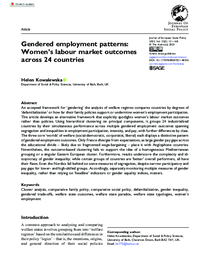Gendered employment patterns: women's labour market outcomes across 24 countries

Journal of European Social Policy
2023
33
2
May
151-168
social policy ; women workers ; labour market ; employment ; equal employment opportunity ; welfare state ; gender equality
Gender equality & Women
https://doi.org/10.1177/09589287221148336
English
Bibliogr.
"An accepted framework for ‘gendering' the analysis of welfare regimes compares countries by degrees of ‘defamilialization' or how far their family policies support or undermine women's employment participation. This article develops an alternative framework that explicitly spotlights women's labour market outcomes rather than policies. Using hierarchical clustering on principal components, it groups 24 industrialized countries by their simultaneous performance across multiple gendered employment outcomes spanning segregation and inequalities in employment participation, intensity, and pay, with further differences by class. The three core ‘worlds' of welfare (social-democratic, corporatist, liberal) each displays a distinctive pattern of gendered employment outcomes. Only France diverges from expectations, as large gender pay gaps across the educational divide – likely due to fragmented wage-bargaining – place it with Anglophone countries. Nevertheless, the outcome-based clustering fails to support the idea of a homogeneous Mediterranean grouping or a singular Eastern European cluster. Furthermore, results underscore the complexity and idiosyncrasy of gender inequality: while certain groups of countries are ‘better' overall performers, all have their flaws. Even the Nordics fall behind on some measures of segregation, despite narrow participatory and pay gaps for lower- and high-skilled groups. Accordingly, separately monitoring multiple measures of gender inequality, rather than relying on ‘headline' indicators or gender equality indices, matters."
Digital
The ETUI is co-funded by the European Union. Views and opinions expressed are however those of the author(s) only and do not necessarily reflect those of the European Union or the ETUI.